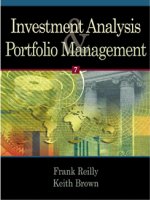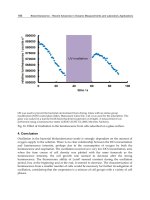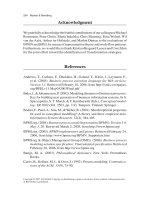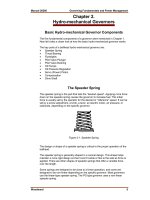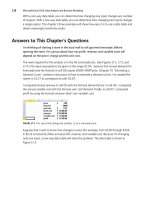advances in Investment Analysis and Portfolio Management phần 10 doc
Bạn đang xem bản rút gọn của tài liệu. Xem và tải ngay bản đầy đủ của tài liệu tại đây (257.68 KB, 21 trang )
Investment Analysis and Portfolio Management
146
Questions and problems
1. Distinguish between a put and a call.
2. What does it mean to say „an option buyer has a right but not an obligation?
3. Explain the following terms used with the options:
a) „In the money“
b) „Out of money“
c) „At the money“
4. What is the difference between option premium and option price?
5. What is the relationship between option prices and their intrinsic value?
6. Why is the call or put writer‘s position considerably different from the buyer‘s
position?
7. What is an index option? What are the main differences between index option and
stock option?
8. How can a put used to protect a particular investor‘s position?
9. What is the maximum amount the buyer of an option can lose?
10. Draw the profit/ loss graph for the following option strategies:
a) Buy a put with 3 EURO premium and 70 EURO exercise price;
b) Write a call with 2 EURO premium and 50 EURO exercise price.
11. Robert has only one day left to decide whether to exercise a call option on the
Company X stock, which he purchased six months ago for 300 dol. (3 dol. per
share). The call option exercise price is 54 dol.
a) For what range of stock price should Robert exercise the call on the last day of
the call life?
b) For what range of stock price would Robert realize a loss (including the
premium paid for the call option)?
12. Using information about several call and put options in the table below, identify,
which of these options are „in the money“, „at the money“ or „out of money“
and fulfill the last column in the table.
Type of option Exercise price Premium Current price of
underlying stock
Your
evaluation
Call 18 0,25 19,50
Put 30 0,50 31,20
Call 24 0,25 21,40
Call 45 0,30 46,10
Put 60 1,25 56,25
Call 20 0,25 20,00
Investment Analysis and Portfolio Management
147
Put 35 1,00 37,80
Put 20 0,80 17,60
Call 65 0,50 65,50
13. Using information in the table above calculate the profit or loss for each option
contract, if they would be exercised.
14. Assume you hold a well-diversified portfolio of common stocks. Under what
conditions might you want to hedge it using a stock index option?
a) Explain how these options can be used for hedging.
b) What happens with your hedged portfolio if the stock market will fall?
c) What happens with your hedged portfolio if the stock market will grow?
References and further readings
1. Arnold, Glen (2010). Investing: the definitive companion to investment and the
financial markets. 2
nd
ed. Financial Times/ Prentice Hall.
2. Black, F., M. Sholes (1973). Pricing of Options and Corporate Liabilities // Journal
of Political Economy, 81, p. 637-654.
3. Fabozzi, Frank J. (1999). Investment Management. 2nd. ed. Prentice Hall Inc.
4. Gitman, Lawrence J., Michael D. Joehnk (2008). Fundamentals of Investing.
Pearson / Addison Wesley.
5. Jones, Charles P.(2010).Investments Principles and Concepts. JohnWiley&Sons
Inc.
6. Levy, Haim, Thierry Post (2005). Investments. FT / Prentice Hall.
7. Rosenberg, Jerry M. (1993).Dictionary of Investing. John Wiley &Sons Inc.
8. Sharpe, William, F. Gordon J. Alexander, Jeffery V.Bailey. (1999) Investments.
International edition. Prentice –Hall International.
9. Thomsett, Michael C. (2010). Options trading for the conservative investor. 2
nd
ed.
Pearson Education.
Relevant websites
• www.fow.com Futures and options world
• ADVFN
• www.bloomberg.com Bloomberg
• www.euronext.com Information and learning tools from NYSE Liffe to
help the private investors
Investment Analysis and Portfolio Management
148
8. Portfolio management and evaluation
Mini content
8.1. Active versus passive portfolio management
8.2. Strategic versus tactical asset allocation
8.3. Monitoring and revision of the portfolio
8.4. Portfolio performance measures.
Summary
Key-terms
Questions and problems
References and further readings
8.1. Active versus passive portfolio management
2 types of investment portfolio management:
• Active portfolio management
• Passive portfolio management
The main points for the passive portfolio management:
• holding securities in the portfolio for the relatively long periods with small
and infrequent changes;
• investors act as if the security markets are relatively efficient. The
portfolios they hold may be surrogates for the market portfolio (index
funds).
• passive investors do not try outperforming their designated benchmark.
The reasons when the investors with passive portfolio management make
changes in their portfolios:
• the investor’s preferences change;
• the risk free rate changes;
• the consensus forecast about the risk and return of the benchmark portfolio
changes.
The main points for the active portfolio management:
• active investors believe that from time to time there are mispriced
securities or groups of securities in the market;
• the active investors do not act as if they believe that security markets are
efficient;
Investment Analysis and Portfolio Management
149
• the active investors use deviant predictions – their forecast of risk and
return differ from consensus opinions.
Table 8.1
Active versus passive investment management
Area of
comparisons
Active investment management Passive investment
management
Aim To achieve better results then
average in the market
To achieve the average market
results
Strategies used and
decision making
Short term positions, the quick
and more risky decisions; keeping
the “hot” strategy
Long term positions, slow
decisions
Investor/manager tense laid-back
Taxes and turnover
of investment
portfolio
High taxes, relatively high
turnover of portfolio
Low taxes, small turnover
of portfolio
Performance results
before costs and
taxes
In average equal to the passively
managed portfolios
In average equal to the actively
managed portfolios
Performance results
after costs and taxes
In average lower than market
index after taxes
In average higher than the
results of actively managed
portfolio returns after taxes
Individual
investors*
Over 85 % from total individual
investors
Over 15 % from total individual
investors
Institutional
investors*
Over 56% from total institutional
investors
Over 44% from total
institutional investors
Supporters All brokerage firms, investment
funds, hedging fund, specialized
investment companies
Passively managed pension
funds, index funds
Analytical methods Qualitative: avoiding risk,
forecasts, emotions, intuition,
success, speculation, gambling
Quantitative: risk management,
long term statistical analysis,
precise fundamental analysis
*Source: Statistical Data of Treasury Department USA, 2006.
Compiled by author on the basis of Cianciotto, 2008; Arnerich, Arnston, Perkins, Pruit at al. (2007);
Voicu (2008); Wellington (2002), Sharpe (1993).
There are arguments for both active and passive investing though it is
probably a case that a larger percentage of institutional investors invest passively than
do individual investors. Of course, the active versus passive investment management
decision does not have to be a strictly either/ or choice. One common investment
strategy is to invest passively in the markets investor considers to be efficient and
actively in the markets investor considers inefficient. Investors also combine the two
by investing part of the portfolio passively and another part actively. Some active and
passive management strategies commonly used for stocks and bonds portfolios were
discussed in Chapters 4.4 and 5.4.
Investment Analysis and Portfolio Management
150
8.2. Strategic versus tactical asset allocation
An asset allocation focuses on determining the mixture of asset classes that is
most likely to provide a combination of risk and expected return that is optimal for the
investor. Asset allocation is a bit different from diversification. It focus is on
investment in various asset classes. Diversification, in contrast, tends to focus more on
security selection – selecting the specific securities to be held within an asset class.
Asset classes here is understood as groups of securities with similar characteristics and
properties (for example, common stocks; bonds; derivatives, etc.). Asset allocation
proceeds other approaches to investment portfolio management, such as market timing
(buy low, sell high) or selecting the individual securities which are expected will be
the “winners”. These activities may be integrated in the asset allocation process. But
the main focus of asset allocation is to find such a combination of the different asset
classes in the investment portfolio which the best matches with the investor’s goals –
expected return on investment and investment risk. Asset allocation largely determines
an investor’s success or lack thereof. In fact, studies have shown that as much as 90 %
or more of a portfolio’s return comes from asset allocation. Furthermore, researchers
have found that asset allocation has a much greater impact on reducing total risk than
does selecting the best investment vehicle in any single asset category.
Two categories in asset allocation are defined:
Strategic asset allocation;
Tactical asset allocation.
Strategic asset allocation identifies asset classes and the proportions for those
asset classes that would comprise the normal asset allocation. Strategic asset allocation
is used to derive long-term asset allocation weights. The fixed-weightings approach in
strategic asset allocation is used. Investor using this approach allocates a fixed
percentage of the portfolio to each of the asset classes, of which typically are three to
five. Example of asset allocation in the portfolio might be as follows:
Asset class Allocation
Common stock 40%
Bonds 50%
Short-term securities 10%___
Total portfolio 100%
Generally, these weights are not changed over time. When market values
change, the investor may have to adjust the portfolio annually or after major market
moves to maintain the desired fixed-percentage allocation.
Investment Analysis and Portfolio Management
151
Tactical asset allocation produces temporary asset allocation weights that
occur in response to temporary changes in capital market conditions. The investor’s
goals and risk- return preferences are assumed to remain unchanged as the asset
weights are occasionally revised to help attain the investor’s constant goals. For
example, if the investor believes some sector of the market is over- or under valuated.
The passive asset allocation will not have any changes in weights of asset classes in
the investor’s portfolio – the weights identified by strategic asset allocation are used.
Alternative asset allocations are often related with the different approaches to
risk and return, identifying conservative, moderate and aggressive asset allocation.
The conservative allocation is focused on providing low return with low risk; the
moderate – average return with average risk and the aggressive – high return and high
risk. The example of these alternative asset allocations is presented in Table 8.2.
Table 8.2.
Comparison between the alternative asset allocations
Alternative asset allocation
Asset class
Conservative Moderate Aggressive
Common stock 20% 35% 65%
Bonds 45% 40% 20%
Short-term securities 35% 15% 5%
Total portfolio 100% 100% 100%
For asset allocation decisions Markowitz portfolio model as a selection
techniques can be used. Although Markowitz model (see Chapter 3.1) was developed
for selecting portfolios of individual securities, but thinking in terms of asset classes,
this model can be applied successfully to find the optimal allocation of assets in the
portfolio. Programs exist to calculate efficient frontiers using asset classes and
Markowitz model is frequently used for the asset allocation in institutional investors’
portfolios.
The correlation between asset classes is obviously a key factor in building an
optimal portfolio. Investors are looking to have in their portfolios asset classes that are
negatively correlated with each other, or at least not highly positively correlated with
each other (see Chapter 2.2). It is obvious that correlation coefficients between asset
classes returns change over time. It is also important to note that the historical
correlation between different asset classes will vary depending on the time period
chosen, the frequency of the data and the asset class, used to estimate the correlation.
Using not historical but future correlation coefficients between assets could influence
Investment Analysis and Portfolio Management
152
the results remarkably, because the historical data may be different from the
expectations.
8.3. Monitoring and revision of the portfolio
Portfolio revision is the process of selling certain issues in portfolio and
purchasing new ones to replace them. The main reasons for the necessity of the
investment portfolio revision:
• As the economy evolves, certain industries and companies become either
less or more attractive as investments;
• The investor over the time may change his/her investment objectives and in
this way his/ her portfolio isn’t longer optimal;
• The constant need for diversification of the portfolio. Individual securities
in the portfolio often change in risk-return characteristics and their
diversification effect may be lessened.
Three areas to monitor when implementing investor’s portfolio monitoring:
1. Changes in market conditions;
2. Changes in investor’s circumstances;
3. Asset mix in the portfolio.
The need to monitor changes in the market is obvious. Investment decisions
are made in dynamic investment environment, where changes occur permanently. The
key macroeconomic indicators (such as GDP growth, inflation rate, interest rates,
others), as well as the new information about industries and companies should be
observed by investor on the regular basis, because these changes can influence the
returns and risk of the investments in the portfolio. Investor can monitor these changes
using various sources of information, especially specialized websites (most frequently
used are presented in relevant websites). It is important to identify he major changes in
the investment environment and to assess whether these changes should negatively
influence investor’s currently held portfolio. If it so investor must take an actions to
rebalance his/ her portfolio.
When monitoring the changes in the investor’s circumstances, following
aspects must be taken into account:
• Change in wealth
• Change in time horizon
• Change in liquidity requirements
Investment Analysis and Portfolio Management
153
• Change in tax circumstances
• Change in legal considerations
• Change in other circumstances and investor’s needs.
Any changes identified must be assessed very carefully before usually they
generally are related with the noticeable changes in investor’s portfolio.
Rebalancing a portfolio is the process of periodically adjusting it to maintain
certain original conditions. Rebalancing reduces the risks of losses – in general, a
rebalanced portfolio is less volatile than one that is not rebalanced. Several methods of
rebalancing portfolios are used:
Constant proportion portfolio;
Constant Beta portfolio;
Indexing.
Constant proportion portfolio. A constant proportion portfolio is one in which
adjustments are made so as to maintain the relative weighting of the portfolio
components as their prices change. Investors should concentrate on keeping their
chosen asset allocation percentage (especially those following the requirements for
strategic asset allocation). There is no one correct formula for when to rebalance. One
rule may be to rebalance portfolio when asset allocations vary by 10% or more. But
many investors find it bizarre that constant proportion rebalancing requires the
purchase of securities that have performed poorly and the sale of those that have
performed the best. This is very difficult to do for the investor psychologically (see
Chapter 6). But the investor should always consider this method of rebalancing as one
choice, but not necessarily the best one.
Constant Beta portfolio. The base for the rebalancing portfolio using this
alternative is the target portfolio Beta. Over time the values of the portfolio
components and their Betas will change and this can cause the portfolio Beta to shift.
For example, if the target portfolio Beta is 1,10 and it had risen over the monitored
period of time to 1,25, the portfolio Beta could be brought back to the target (1,10) in
the following ways:
• Put additional money into the stock portfolio and hold cash. Diluting the
stocks in portfolio with the cash will reduce portfolio Beta, because cash has
Beta of 0. But in this case cash should be only a temporary component in the
portfolio rather than a long-term;
Investment Analysis and Portfolio Management
154
• Put additional money into the stock portfolio and buy stocks with a Beta
lower than the target Beta figure. But the investor may be is not able to
invest additional money and this way for rebalancing the portfolio can be
complicated.
• Sell high Beta stocks in portfolio and hold cash. As with the first
alternative, this way reduces the equity holdings in the investor’s portfolio
which may be not appropriate.
• Sell high Beta stocks and buy low Beta stocks. The stocks bought could
be new additions to the portfolio, or the investor could add to existing
positions.
Indexing. This alternatives for rebalancing the portfolio are more frequently
used by institutional investors (often mutual funds), because their portfolios tend to be
large and the strategy of matching a market index are best applicable for them.
Managing index based portfolio investor (or portfolio manager) eliminates concern
about outperforming the market, because by design, it seeks to behave just like the
market averages. Investor attempts to maintain some predetermined characteristics of
the portfolio, such as Beta of 1,0. The extent to which such a portfolio deviates from
its intended behaviors called tracking error.
Revising a portfolio is not without costs for an individual investor. These
costs can be direct costs – trading fees and commissions for the brokers who can
trade securities on the exchange. With the developing of alternative trading systems
(ATS) these costs can be decreased. It is important also, that the selling the securities
may have income tax implications which differ from country to country.
1.4.Portfolio performance measures
Portfolio performance evaluation involves determining periodically how the
portfolio performed in terms of not only the return earned, but also the risk
experienced by the investor. For portfolio evaluation appropriate measures of return
and risk as well as relevant standards (or “benchmarks”) are needed.
In general, the market value of a portfolio at a point of time is determined by
adding the markets value of all the securities held at that particular time. The market
value of the portfolio at the end of the period is calculated in the same way, only
using end-of-period prices of the securities held in the portfolio.
The return on the portfolio (r
p
):
Investment Analysis and Portfolio Management
155
r
p
= (V
e
- V
b)
/
V
b,
(8.1)
here: V
e
- beginning value of the portfolio;
V
b
- ending value of the portfolio.
The essential idea behind performance evaluation is to compare the returns
which were obtained on portfolio with the results that could be obtained if more
appropriate alternative portfolios had been chosen for the investment. Such
comparison portfolios are often referred to as benchmark portfolios. In selecting them
investor should be certain that they are relevant, feasible and known in advance. The
benchmark should reflect the objectives of the investor.
Portfolio Beta (see Chapter 3.3) can be used as an indication of the amount of
market risk that the portfolio had during the time interval. It can be compared directly
with the betas of other portfolios.
You cannot compare the ex post or the expected and the expected return of two
portfolios without adjusting for risk. To adjust the return for risk before comparison of
performance risk adjusted measures of performance can be used:
Sharpe’s ratio;
Treynor’s ratio;
Jensen’s Alpha.
Sharpe’s ratio shows an excess a return over risk free rate, or risk premium, by
unit of total risk, measured by standard deviation:
Sharpe’s ratio = (ř
p
– ř
f
) / σ
p
, (8.2)
here: ř
p
- the average return for portfolio p during some period of time;
ř
f
- the average risk-free rate of return during the period;
σ
p
- standard deviation of returns for portfolio p during the period.
Treynor’s ratio shows an excess actual return over risk free rate, or risk
premium, by unit of systematic risk, measured by Beta:
Treynor’s ratio = (ř
p
–ř
f
) / β
p
, (8.3)
here: β
p
– Beta, measure of systematic risk for the portfolio p.
Jensen‘s Alpha shows excess actual return over required return and excess
of actual risk premium over required risk premium. This measure of the portfolio
manager’s performance is based on the CAPM (see Chapter 3.2).
Investment Analysis and Portfolio Management
156
Jensen’s Alpha = (ř
p
– ř
f
) – β
p
(ř
m
–ř
f
), (8.4)
here: ř
m
- the average return on the market in period t;
(ř
m
–ř
f
) - the market risk premium during period t.
It is important to note, that if a portfolio is completely diversified, all of these
measures (Sharpe, Treynor’s ratios and Jensen’s alfa) will agree on the ranking of the
portfolios. The reason for this is that with the complete diversification total variance is
equal to systematic variance. When portfolios are not completely diversified, the
Treynor’s and Jensen’s measures can rank relatively undiversified portfolios much
higher than the Sharpe measure does. Since the Sharpe ratio uses total risk, both
systematic and unsystematic components are included.
Summary
1. The main points of passive portfolio management: holding securities in the
portfolio for the relatively long periods with small and infrequent changes;
investors act as if the security markets are relatively efficient; passive investors do
not try outperforming their designated benchmark.
2. The main points for the active portfolio management: active investors believe that
there are mispriced securities or groups of securities in the market; the active
investors do not act as if they believe that security markets are efficient; the active
investors use deviant predictions – their forecast of risk and return differ from
consensus opinions.
3. Strategic asset allocation identifies asset classes and the proportions for those asset
classes that would comprise the normal asset allocation. Strategic asset allocation
is used to derive long-term asset allocation weights. The fixed-weightings
approach in strategic asset allocation is used.
4. Tactical asset allocation produces temporary asset allocation weights that occur in
response to temporary changes in capital market conditions. The investor’s goals
and risk- return preferences are assumed to remain unchanged as the asset weights
are occasionally revised to help attain the investor’s constant goals.
5. For asset allocation decisions Markowitz portfolio model as a selection techniques
can be used. Thinking in terms of asset classes, this model can be applied
successfully to find the optimal allocation of assets in the portfolio. The
correlation between asset classes is a key factor in building such an optimal
portfolio. Investors are looking to have in their portfolios asset classes that are
Investment Analysis and Portfolio Management
157
negatively correlated with each other, or at least not highly positively correlated
with each other
6. Portfolio revision is the process of selling certain issues in portfolio and
purchasing new ones to replace them.
7. Three areas to monitor when implementing investor’s portfolio monitoring: (1)
Changes in market conditions; (2) Changes in investor’s circumstances; (3) Asset
mix in the portfolio.
8. When monitoring the changes in the investor’s circumstances, following aspects
must be taken into account: change in wealth; change in time horizon; change in
liquidity requirements; change in tax circumstances; change in legal
considerations; change in other circumstances and investor’s needs.
9. Rebalancing a portfolio is the process of periodically adjusting it to maintain
certain original conditions. Rebalancing reduces the risks of losses – in general, a
rebalanced portfolio is less volatile than one that is not rebalanced.
10. A constant proportion portfolio is one of the portfolio rebalancing methods in
which adjustments are made so as to maintain the relative weighting of the
portfolio components as their prices change. Investors should concentrate on
keeping their chosen asset allocation percentage (especially those following the
requirements for strategic asset allocation).
11. The bases for the rebalancing portfolio using constant Beta portfolio alternative is
the target portfolio Beta. Over time the values of the portfolio components and
their Betas might change. This can cause the portfolio Beta to shift and then the
portfolio Beta should be brought back to the target.
12. Using indexing method for rebalancing the portfolio the investors match a market
index best applicable for them. Managing index based portfolio investor (or
portfolio manager) eliminates concern about outperforming the market, because by
design, it seeks to behave just like the market averages.
13. Portfolio performance evaluation involves determining periodically how the
portfolio performed in terms of not only the return earned, but also the risk
experienced by the investor. For portfolio evaluation appropriate measures of
return and risk as well as relevant standards (or “benchmarks”) are needed. In
selecting benchmark portfolios investor should be certain that they are relevant,
Investment Analysis and Portfolio Management
158
feasible and known in advance. The benchmark should reflect the objectives of the
investor.
14. To adjust the return for risk before comparison of performance risk adjusted
measures of performance can be used. Sharpe’s ratio shows an excess a return over
risk free rate, or risk premium, by unit of total risk, measured by standard
deviation. Treynor’s ratio shows an excess actual return over risk free rate, or risk
premium, by unit of systematic risk, measured by Beta. Jensen‘s Alpha shows
excess actual return over required return and excess of actual risk premium over
required risk premium. This measure of the portfolio manager’s performance is
based on the CAPM.
Key-terms
• Asset classes
• Asset allocation
• Sharpe’s ratio
• Treynor’s ratio
• Jensen’s Alpha
• Benchmark portfolios
• Tracking error
• Constant proportion portfolio method
• Constant Beta portfolio method
• Indexing method
• Rebalancing a portfolio
• Portfolio monitoring
• Portfolio revision
• Strategic asset allocation
• Tactical asset allocation.
• Active portfolio management
• Passive portfolio management
Questions and problems
1. Give the arguments for active portfolio management.
2. What are the reasons which cause investors managing their portfolios passively to
make changes their portfolios?
3. What are the major differences between active and passive portfolio management?
4. Explain the role of revision in the process of managing a portfolio.
5. Distinguish strategic and tactical asset allocation.
6. What role does current market information play in managing investment portfolio?
7. Why is the asset allocation decision the most important decision made by
investors?
8. What is the point of investment portfolio rebalancing?
Investment Analysis and Portfolio Management
159
9. What changes in investor’s circumstances cause the rebalancing of the investment
portfolio? Explain why.
10. Why is portfolio revision not free of cost?
11. Why benchmark portfolios are important in investment portfolio management?
12. Briefly describe each of the portfolio performance measures and explain how they
are used:
a) Sharpe’s ratio;
b) Treynor’s ratio;
c) Jensen’s Alpha.
13. Assume that you plan to construct a portfolio aimed at achieving your stated
objectives. The portfolio can be constructed by allocating your money to the
following asset classes: common stock, bonds, and short-term securities.
a) Identify state and comment your investment objectives.
b) Determine an asset allocation to these three classes of assets considering
your stated investment objectives. Explain your decision.
c) What reasons could cause you to make changes in your asset allocations?
14. An investor’s portfolio consists of 50000 EURO in stocks and 5000 EURO in
cash. the Beta of the portfolio is 1,10. How the investor could reduce Beta of the
portfolio to 0,95? Show and explain.
15. Select four stocks which were actively traded in the local stock exchange last
calendar year, find the information about their prices at the beginning and at the
end of the year, amount of dividends paid on each stock for this year and stock
Beta at the end of the year. Also find a risk-free rate of return and the market
return for the given year. Assume that these four stocks were put to the portfolio
in equal proportions (25% in each stock). Assume that the standard deviation for
this portfolio is 16, 75% and that standard deviation for the market portfolio is
13, 50%.
a) Find the portfolio return for the given year (see chapter 3.1.2, formula 3.1).
b) Calculate Sharpe’s, Treynor’s ratios and Jensen’s Alpha.
c) Compare and comment the results of measuring portfolio performance with
different measures.
Investment Analysis and Portfolio Management
160
References and further readings
1. Arnerich, T., at al. (2007) Active .versus passive investment management: putting
the debate into perspective // Journal of Financial Research, spring.
2. Arnold, Glen (2010). Investing: the definitive companion to investment and the
financial markets. 2
nd
ed. Financial Times/ Prentice Hall.
3. Bogle, J.C. (2001) Three challenges of investing: active management, market
efficiency, and selecting managers // Journal of Financial Research, spring.
4. Brands, S., Brown, S. J., Gallagher, D.R. (2005) Portfolio concentration and
investment performance // Journal of Banking and Finance, spring.
5. Brands, S., Gallagher, D.R., Looi, A. (2003) Active investment manager portfolios
and preferences for stock characteristics: Australian evidence // Securities Industry
Research Centre of Asia-Pacific.
6. Cianciotto, Ph. (2008) Improving your investment returns – passive or active
investing // AAL financial planning association.
7. Fabozzi, Frank J. (1999). Investment Management. 2nd. ed. Prentice Hall Inc.
8. Francis, Jack C., Roger Ibbotson (2002). Investments: A Global Perspective.
Prentice Hall Inc.
9. Gallagher, D.R. (2003) Investment manager characteristics, strategy, top
management changes and fund performance // The Journal of Banking and
Finance, spring.
10. Gallagher, D.R., Nadarajah, P. (2004) Top management turnover: an analysis of
active Australian investment managers // The Journal of Banking and Finance,
winter.
11. Gitman, Lawrence J., Michael D. Joehnk (2008). Fundamentals of Investing.
Pearson / Addison Wesley.
12. Gold, M. (2004) Investing in pseudo-science: the `active versus passive` debate //
The Journal of Financial Research, spring.
13. Jones, Charles P. (2010). Investments Principles and Concepts. John Wiley &
Sons, Inc.
14. LeBarron, Dean, Romeesh Vaitilingam. (1999). Ultimate Investor. Capstone.
15. Nakamura, L. (2005) A comparison of active and passive investment strategies //
The Journal of Financial Research, spring.
Investment Analysis and Portfolio Management
161
16. Rice, M., Strotman, G. (2007) The next chapter in the active vs. passive
management debate // LLC research and analysis, spring.
17. Rosenberg, Jerry M. (1993).Dictionary of Investing. John Wiley &Sons Inc.
18. Sharpe, William. The Arithmetic of Active Management. // Financial Analysis
Journal, 1991.
19. Strong, Robert A. (1993). Portfolio Construction, Management and Protection.
West Publishing Company.
20. Voicu, A., (2008) Passive vs. active investment management strategies // The
financial planning association, spring.
21. Wellington, J.W. (2002) Active vs. passive management // The Journal of
Financial Research, spring.
Relevant websites
• www.morningstar.co.uk Morningstar UK
• www.funds.ft.com/funds Financial Times Fund Services
• www.funds-sp.com Standard &Poor‘s Fund Service
ABBREVIATIONS AND SYMBOLS USED
Abbreviation or symbol Explanation
A
J
Intercept – the point where the characteristic line of
security J passes through the vertical axis
ABS Asset-Backed Securities
APT Arbitrage Pricing Theory
ATS Alternative Trading System
β
J
Beta of security J, the measure of systematic risk
β
p
Beta of portfolio
CAPM Capital Asset Pricing Model
CF Cash Flow
CML Capital Market Line
Cov (r
A
, r
B
) Covariance between returns of two assets – A and B
CY Current Yield
C
t
Coupon payment in time period t
D Dividends
D
L
Long-term debt
DC Depreciation
DDM Dividend Discount Models
Det
A,B
Coefficient of determination between the returns of assets
A and B
DR Duration (Macaulay duration)
E Exercise (strike) price
EBIT Earnings Before Interest and Taxes
ECB European Central Bank
E(r) Expected rate of return
E(r
m
) Expected rate of return on the market
E(r
p
) Expected rate of return on the portfolio
EPS Earnings per Share
E-I-C Economy-Industry-Company Analysis
g Growth rate
GDP Gross Domestic Product
h Probability
HR Hedge Ratio
I Interest expense
IV Intrinsic value of the option
IPO Initial Public Offerings
k Discount rate
k
A,B
Coefficient of correlation between the returns of assets A
and B
LP Lease payments
NAV Net Asset Value
NI Net Income
OTC Over-the-Counter Market
P
m
Market price
Investment Analysis and Portfolio Management
163
P
n
Face value (nominal value) of the bond
P
op
Option premium
PER Price/Earnings Ratio
PER* Normative Price/ Earnings ratio
r Rate of return
ŕ Arithmetic average return or Sample mean of returns
r
m
Return on the market
R
f
Risk-free rate of return
REPO Repurchase Agreement
ROA Return on Assets
ROE Return on Equity
ROI Return on Investment
SE
T
Total stockholders’ equity
SML Security Market Line
T
r
Income tax rate
TV Time value of the option
V Intrinsic (investment) value
YTC Yield-To-Call
YTM Yield-To-Maturity
YTM* Appropriate Yield-To -Maturity
σ
p
Risk of the portfolio measured as standard deviation
σ
r
Standard deviation of returns
σ²
r
Variance of Returns
Investment Analysis and Portfolio Management
164
BIBLIOGRAPHY
Ackert, Lucy F., Deaves, Richard (2010). Behavioral Finance. South-Western Cengage
Learning.
Arnold, Glen (2010). Investing: the definitive companion to investment and the
financial markets. 2
nd
ed. Financial Times/ Prentice Hall.
Black, John, Nigar Hachimzade, Gareth Myles (2009). Oxford Dictionary of
Economics. 3
rd
ed. Oxford University Press Inc., New York.
Bode, Zvi, Alex Kane, Alan J. Marcus (2005). Investments. 6th ed. McGraw Hill.
Encyclopedia of Alternative Investments/ ed. by Greg N. Gregoriou. CRC Press, 2009.
Fabozzi, Frank J. (1999). Investment Management. 2nd. ed. Prentice Hall Inc.
Francis, Jack C., Roger Ibbotson (2002). Investments: A Global Perspective. Prentice
Hall Inc.
Gitman, Lawrence J., Michael D. Joehnk (2008). Fundamentals of Investing. Pearson /
Addison Wesley.
Haan, Jakob, Sander Oosterloo, Dirk Schoenmaker (2009). European Financial
Markets and Institutions. Cambridge University Press.
Haugen, Robert A. (2001). Modern Investment Theory. 5
th
ed. Prentice Hall.
Jones, Charles P. (2010). Investments Principles and Concepts. John Wiley & Sons,
Inc.
LeBarron, Dean, Romeesh Vaitilingam. (1999). Ultimate Investor. Capstone.
Levy, Haim ,Thierry Post (2005). Investments. FT / Prentice Hall.
Nicolaou, Michael A. (2000). The Theory and Practice of Security Analysis.
MacMillan Business.
Nofsinger, John R. (2008). The Psychology of Investing. 3rd ed. Pearson/Prentice
Hall.
Rosenberg, Jerry M. (1993).Dictionary of Investing. John Wiley &Sons Inc.
Sharpe, William, F. Gordon J. Alexander, Jeffery V.Bailey. (1999) Investments.
International edition. Prentice –Hall International.
Strong, Robert A. (1993). Portfolio Construction, Management and Protection.
Wilmott, Paul (2009). Frequently Asked Questions in Quantitative Finance. 2
nd
ed.
John Wiley and Sons, Ltd.
Investment Analysis and Portfolio Management
165
Annex 1.
Definitions of long-term credit ratings
Moody's
S&P
Fitch Ratings
Definition
Aaa AAA AAA Prime. Maximum Safety
Aa1 AA+ AA+ High Grade High Quality
Aa2 AA AA
Aa3 AA- AA-
A1 A+ A+ Upper Medium Grade
A2 A A
A3 A- A-
Baa1 BBB+ BBB+ Lower Medium Grade
Baa2 BBB BBB
Baa3 BBB- BBB-
Ba1 BB+ BB+ Non-Investment Grade
Ba2 BB BB
Ba3 BB- BB-
B1 B+ B+ Highly Speculative
B2 B B
B3 B- B-
Caa1 CCC+ CCC In Poor Standing
Caa2 CCC -
Caa3 CCC- -
Ca CC CC Extremely Speculative
C C C May be in Default
- - DDD Default
- - DD
- D D
Source: Ministry of Finance of the Republic of Lithuania. www.finmin.lt
Investment Analysis and Portfolio Management
166
Annex 2.
Black-Scholes formula for estimating the fair value of the call options
Vc = N(d
1
) * P
s
- [E*R* T* N(d
2
)] / e,
(1)
here P
s
- current market price of the underlying stock;
E - exercise price of the option;
R - continuously compounded risk free rate of return expressed on the annual
basis;
T - time remaining before expiration, expressed as a fraction of a year
N(d
1
) and N(d
2
) denote the probabilities that outcomes of less d
1
and d
2
respectively.
N(d
1
) = ln (P
s
/E) + [(R + 0,5 δ
δδ
δ)*T] / δ
δδ
δ
√
T; (2)
N(d
2
) = ln ( P
s
/E) + [(R – 0,5 δ
δδ
δ)* T] / -δ
δδ
δ
√
T, (3)
here: δ - risk o the underlying common stock, measured by the standard deviation
of the continuously compounded annual rate of return on the stock.
